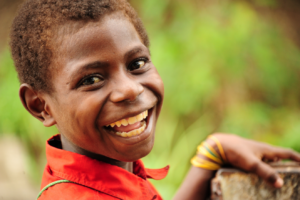Non-traditional actors align nutrition priorities in Papua New Guinea
* Originally published by the UN Network An unusual combination of factors characterizes the nutrition profile of Papua New Guinea (PNG), located on the eastern half of New Guinea in Melanesia. For the largely rural population of eight million, with only 18 percent in urban…
* Originally published by the UN Network
An unusual combination of factors characterizes the nutrition profile of Papua New Guinea (PNG), located on the eastern half of New Guinea in Melanesia. For the largely rural population of eight million, with only 18 percent in urban areas, child under-five stunting impacts one out of every two children, about double the 25 percent average for developing countries. The causes, stemming from poverty, include environmental issues, poor access to markets and others. These figures come from the Papua New Guinea Household Income and Expenditure Survey (HIES), conducted in 2009─2010. The absence of more current data highlights two areas that need urgent attention if nutrition governance is going to be improved: capacity building and budget allocation.
“In PNG, there are virtually no donors. If you are talking about nutrition, there is no competition for space. No rubbing shoulders for the same resources. You have to generate your own internal resources, because of its status as a lower-middle income country,” explained Hanifa Namusoke, a nutrition specialist for UNICEF, who worked in PNG from 2015 through 2019.
The World Bank classifies PNG as a ‘low to middle income’ country. Agriculture and livestock; forestry; and mining and petroleum are the top three revenue generators. This status acts as a deterrent to donors. Those who fund nutrition interventions in countries with lower economic status are not active in PNG. However, in the same way that the COVID-19 pandemic has yielded a few unexpected benefits, so too does this give PNG a hidden advantage. Without donor funds, development partners have had to band together, with greater urgency than they would in another setting, to align their efforts with government and impact the local population.
This has given rise to less ‘traditional’ United Nations agencies taking part in the UN Network (UNN). Along with expected members such as the United Nations Children’s Fund (UNICEF), the Food and Agriculture Organization of the United Nations (FAO) and the World Health Organization (WHO), the United Nations Capital Development Fund (UNCDF) and the United Nations Development Programme (UNDP) have actively participated in the nutrition arena. Even if the UN colleagues do not refer to the group as the UN Network per se, there is considerable collaboration on nutrition among these agencies and interesting institutional arrangements for doing so. These efforts were bolstered by then United Nations Resident Coordinator (UNRC) Roy Trivedy, who was pivotal in ensuring that the costed National Nutrition Strategic Action Plan for 2018─2022 was accepted by PNG’s government.
Two coordination bodies: People and Prosperity
Coalitions for multi-sectoral coordination are divided into two groups, articulated by the United Nations Development Assistance Framework (UNDAF) 2018–2022: ‘People’ and ‘Prosperity’. This link is important in formalizing UN coordination architecture for nutrition and creating buy-in among the agencies. As the larger of the two, the People group covers sectors for health, nutrition, HIV/AIDS, gender-based violence, and water, sanitation and hygiene (WASH). Concurrently, the ‘Prosperity Group’ views similar issues through an economic lens. These coalitions clarify priorities to present to UN and government leadership.
Coordination happens within each group as well as between them. They worked together to develop PNG’s first National Nutrition Policy (2016–2026) as well as a Strategic Action Plan that was completed in 2018, revised in 2019, and launched in October of the same year. Currently, both groups share a focus on the reduction of the country’s alarming stunting levels (50 percent nationally) when advocating for nutrition policy with local government.
A unique chairing arrangement features two chairs and two co-chairs. UNICEF serves as the chair and WHO the co-chair for the People contingency, while UNCDF (chair) and FAO (co-chair) co-host the Prosperity Group.
Group planning is translated into individual mandates for individual organizations such as UNICEF or UNDP. PNG is part of the ‘Delivering as One’ (DaO) initiative, which reinforces efforts to address stunting and wasting as part of Sustainable Development Goal 2 (SDG2), among others. UNICEF focuses on direct nutrition interventions, such as infant and young child feeding, and FAO complements with its technical assistance on nutrition-sensitive agriculture. A third partner, the World Bank, provided a loan to support both policies.
In 2011, stunting was not positioned among PNG’s outcome areas in the UNDAF 2012─2017 – an oversight with dire consequences. In the most recent UNDAF 2018–2022, stunting is now emphasized as a direct result of the ‘People Group’. A third example is the support given by the United Nations Population Fund (UNFPA) and UNICEF at health clinics in rural areas where health workers hold information sessions with mothers on self-care, parenting techniques and nutrition.
Integration with local government
In 2018−19, the UNN collaborated with the SUN Civil Society Alliance (CSA) Network to bring the Prime Minister and the Minister of National Planning and Monitoring on board as ‘nutrition champions.’ Additionally, the UNN provided technical support to civil society organizations (CSOs) and academia for nutrition-related research activities that fed into advocacy. Together, these efforts helped nutrition secure a more prominent place on the political agenda, leading to the Prime Minister’s call to action to rise up against malnutrition one household at a time.
• Read the full article on UN Network website: Non-traditional actors align nutrition priorities in Papua New Guinea

